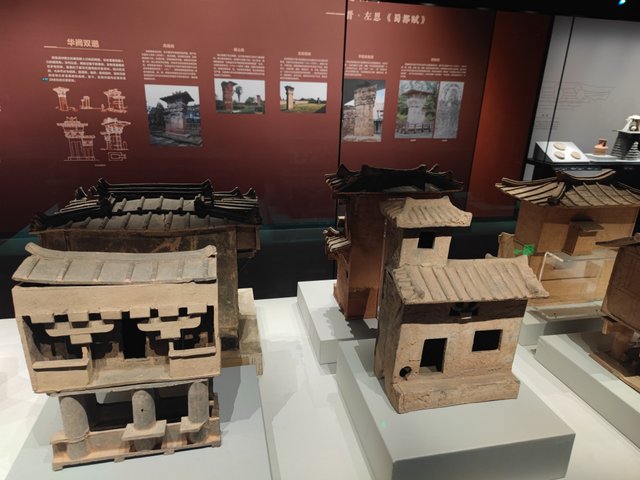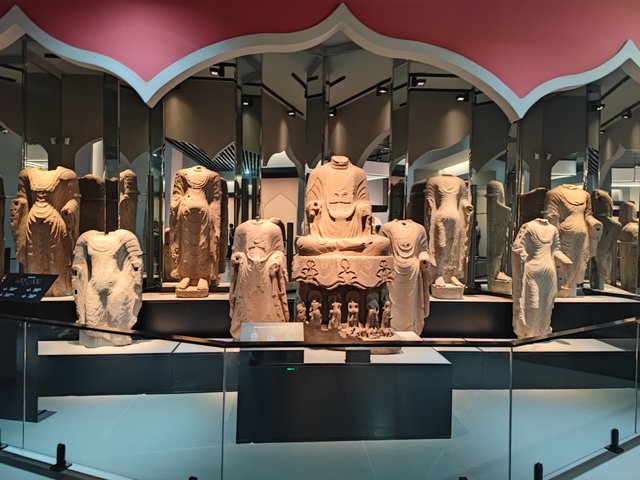详聊四川博物馆(汉——南北朝)

今天接着讲一讲四川博物馆看到的一些展品跳到暗带的标志了。汉代的文物除了陶俑,还有各种砖画之外,出现最多的就是陶制的房屋模型。从中可以看出,在两千多年前,中国人就已经对房屋看的非常的重要了。也难怪在两千年后的今天,房地产会成为中国的支柱产业,而房地产业的兴衰涨跌,也成为了牵动中国经济的头等大事。也许这其中也有某种传承吧。
这些陶制的房屋模型大多是有围墙的院落。其中有的还有多层小楼,不过大多也都只有一座院落,也不像是大富大贵之家。可以看得出,那个时期应该是居住在这样的院落中的住户,应该也就是那个时代的中产阶级,而且有的院落中还有饲养牲畜的猪圈。如果是大富大贵的家族居住的肯定是比这大的多的院落,也不会在自己的居住空间中饲养有气味的牲畜。
总之,从这些文物中可以看出,西汉初年算是一个经济相对繁荣,中产阶级逐步壮大的时期。如果那时候有基尼系数的话,应该不会很高。可惜这条道路并没有一直走下去。从汉景帝平定了七国之乱开始,汉朝的政治趋向于中央集权政府。朝廷从民间的汲取,也给民众造成越来越沉重的负担。直到汉武帝这个所谓的千古一帝,完全建立起了中央集权的体制,成为后世中原王朝的政治体制的主要样板。像汉初这样共同富裕的局面就很少在中国历史上出现了。

两汉三国结束之后,经过了西晋的短暂统一,中国又陷入了五胡乱华的时代,最终形成了南北对峙的南北朝时期。在这一时期,佛教文化大大的兴盛,展出的文物当中出现了很多佛像。不过奇怪的是,佛像的身体和头是分离的。从这些佛像雕塑的情况来看,五官更加细致逼真,而佛像身上的衣服的纹理和褶皱都表现的丝丝入扣。那种曾经在秦兵马俑身上出现过的,类似希腊雕塑风格的写实主义雕塑似乎又回来了。
这其实与历史上著名的亚历山大大帝东征有关。亚历山大对东方的征服堪称奇迹,几乎是战无不胜,包括摧毁了历史悠久的庞大的波斯帝国,使得亚历山大的大名威名远播,在中亚地区被当做战神的代名词。甚至有种说法。安史之乱的祸首。胡人出身的渔阳节度使安禄山,他的名字就是亚历山大的音译。因为安禄山出生的粟特人就生活在曾经被亚历山大征服过的中亚河中地区。

虽然亚历山大用很短的时间就建立起了覆盖当时整个已知世界(除去东亚之外)的庞大帝国。但是在他死后,这个大帝国就分崩离析了。但是,很多跟随亚历山大出征的希腊人,却在中亚和北印度地区扎下根来和当地的文化融合在了一起。后世还建立了许多希腊化的政权,像和汉武帝交易汗血宝马的大宛就是一个希腊化的国家。,而从三国到南北朝时期,这一地区也曾经崛起过几个希腊化的国家,比如巴克克特里亚王国和贵霜帝国。这些希腊化的国家将希腊的雕刻艺术和佛教文化结合在一起,形成了独特独树一帜的健陀罗雕塑风格。一个很明显的特征就是绝大多数佛像的身后都有一圈神圣的光环,而这一特征就是取材于希腊神话中太阳神阿波罗的形象。而这一时期中国的佛教雕塑在很大程度上也是受希腊化的健陀罗风格的影响。
![IMG_20231107_134555.jpg] ( )
)
Today, I will talk about some of the exhibits I saw in the Sichuan Museum, which jumped to the logo of the dark band. In addition to terracotta figurines and various brick paintings, the most common cultural relics of the Han Dynasty are pottery house models. It can be seen that more than 2,000 years ago, Chinese have already regarded houses as very important. It is no wonder that today, 2,000 years later, real estate will become a pillar industry in China, and the rise and fall of the real estate industry has also become the top priority affecting China's economy. Maybe there's some kind of inheritance in that.
Most of these pottery house models are walled courtyards. Some of them also have multi-storey small buildings, but most of them have only one courtyard, and they don't look like rich and noble homes. It can be seen that the residents of such a courtyard at that time should have been the middle class of that era, and some of the courtyards also had pigpens for raising livestock. If it is a wealthy family, it must live in a much larger courtyard than this, and it will not raise smelly livestock in its own living space.
In short, it can be seen from these cultural relics that the early years of the Western Han Dynasty were a period of relative economic prosperity and the gradual growth of the middle class. If there had been a Gini coefficient at that time, it would not have been very high. It's a pity that this path didn't go all the way. From the time Emperor Jing of the Han Dynasty put down the Rebellion of the Seven Kingdoms, the politics of the Han Dynasty tended to be a centralized government. The imperial court's absorption from the people also caused an increasingly heavy burden on the people. It was not until Emperor Wu of the Han Dynasty, the so-called Emperor of the Ages, that he completely established a centralized system and became the main model of the political system of the Central Plains Dynasty in later generations. Such a situation of common prosperity as in the early Han Dynasty has rarely occurred in Chinese history.
![image.png] ( )
)
After the end of the Han Dynasty and the Three Kingdoms, after a short period of unification in the Western Jin Dynasty, China fell into the era of Wuhu Chaohua, and finally formed the period of the Northern and Southern Dynasties of confrontation between the north and the south. During this period, Buddhist culture flourished, and many Buddha statues appeared among the cultural relics on display. Strangely enough, though, the body and head of the Buddha statue are separated. Judging from the situation of these Buddha sculptures, the facial features are more detailed and realistic, and the texture and folds of the clothes on the Buddha statues are meticulously expressed. The kind of realist sculpture that once appeared on the Qin terracotta warriors, similar to the Greek sculpture style, seems to be back.
This is actually related to the famous Eastern Crusade of Alexander the Great in history. Alexander's conquests of the East were miraculous and almost invincible, including the destruction of the vast Persian Empire, which had a long history, making Alexander's fame so famous that he was synonymous with the god of war in Central Asia. There is even a saying. The culprit of the Anshi Rebellion. An Lushan, the Yuyang Jiedu envoy from the Hu people, his name is the transliteration of Alexander. Because the Sogdians, who were born in An Lushan, lived in the riverine region of Central Asia, which had been conquered by Alexander.
![IMG_20231107_135340.jpg] ( )
)
Although it took a short time for Alexander to build a vast empire that covered the entire known world (excluding East Asia) at the time. But after his death, the great empire fell apart. However, many of the Greeks who followed Alexander on his expedition took root in Central Asia and North India and blended with the local culture. Later generations also established many Hellenistic regimes, such as Dawan, who traded with Emperor Wu of the Han Dynasty. From the Three Kingdoms to the Northern and Southern Dynasties, several Hellenistic states also arose in this region, such as the Kingdom of Bactria and the Kushan Empire. These Hellenistic countries combined the art of Greek carving with the culture of Buddhism to form a unique style of Gandhara sculpture. One obvious feature is that most Buddha statues have a sacred halo behind them, and this feature is taken from the image of Apollo, the god of the sun in Greek mythology. Chinese Buddhist sculpture during this period was also largely influenced by the Hellenistic Gandhara style.
Upvoted! Thank you for supporting witness @jswit.